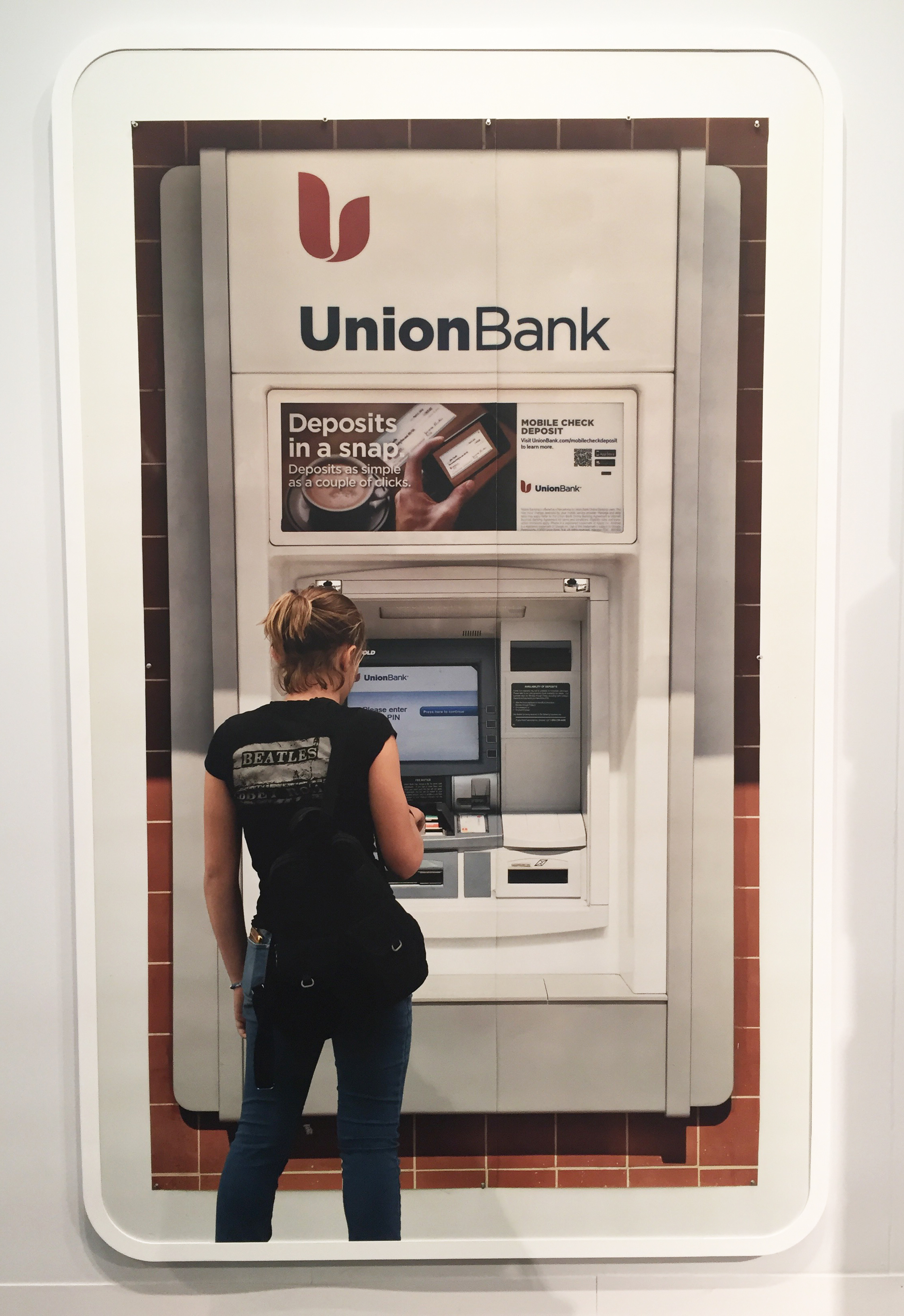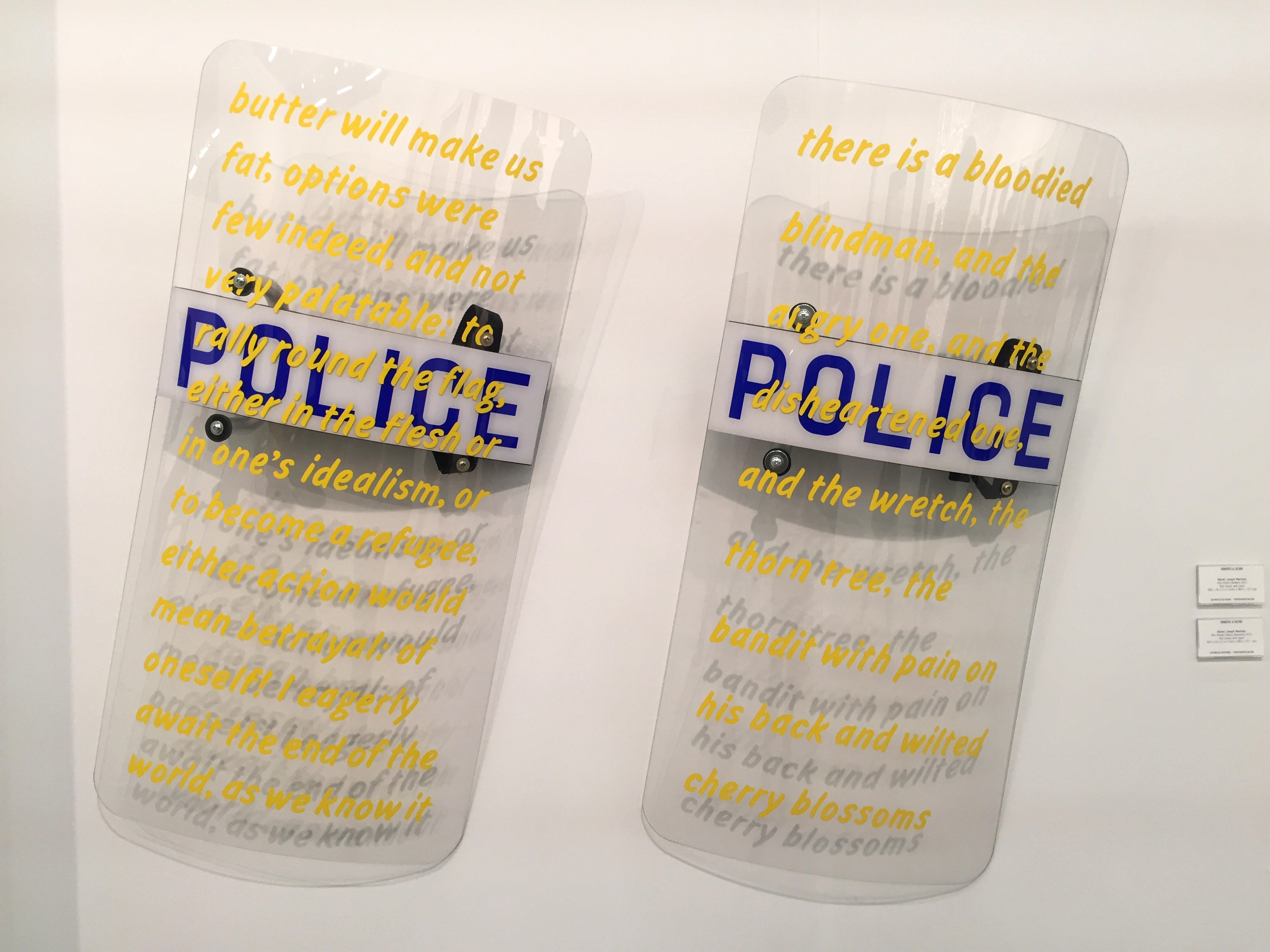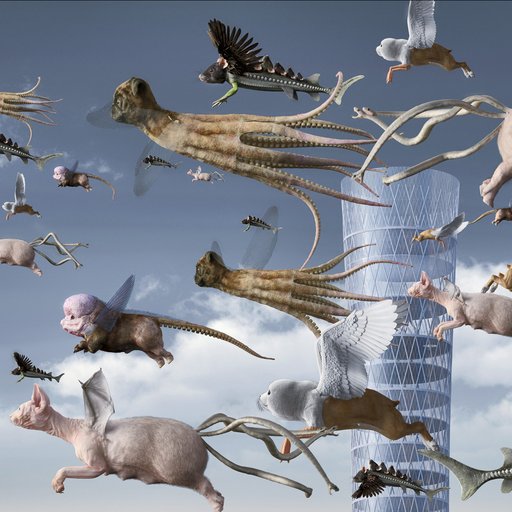The Armory Show opened its doors to press and VIP on Wednesday and like it has every year, wowed fair-goers with jaw-dropping, eye-catching artworks. And while there’s nothing wrong with eye candy (we’ve come to expect it particularly during fair season), we hoped to find at least a few works that attempt to reveal, reflect, or announce something having to do with this profoundly unsettling time we find ourselves in. (It’s worth noting that the Armory’s “Focus” section, which in the past had been organized around various, seemingly arbitrary geographical locations, was this year dedicated to answering the question, “What Is to Be Done?”—the title of the section, curated by Jarrett Gregory.) So, without further ado, here are nine artworks on view at the Armory that actually mean something.
BRANDON LATTU
Girl with Image of Automated Teller Machine
(2016)
Koenig & Clinton, New York
$18,000 (Edition of 3)

The formal logic of Brandon Lattu’s images can be tricky to decipher at first glance, so let’s make it easy: Girl with Image of Automated Teller Machine is a photograph of a woman standing in front of a photograph. The photograph she’s standing in front of shows an ATM which features yet another image advertising the very technology that will eventually replace it: the smart phone. The woman, presumably in her twenties at most, will most likely live during a time when physical currency no longer circulates. Outmoded technology is what makes Lattu tick—and his works make us evaluate our relationships to landscapes and objects when interactions (like the one pictured above) become increasingly immaterial.
TERESA MARGOLLES
Karla, Hilario Reyes Gallegos
(2016)
Peter Kilchmann, Zurich
$70,000
Everything in this Swiss gallery’s "Focus" booth is a monument to the late Karla, a transgender sex worker who was beaten to death by two young men in Juarez, Mexico. A concrete stone taken from the building where she was found, a framed death certificate, the recorded voice of a friend recounting the incident emanating from two speakers, and the pictured black-and-white photograph of Karla tell a story not about the life of this person, but about her death. Violence against transgender people have always been far too prevalent, but with additional threats to trans- and LGBTQ-rights coming top-down from the current U.S. administration, stories like Karla’s are ever-more poignant. To Margolles, Karla’s story isn’t only a cautionary one, but rather is intimately personal; the artist got to know her well while they collaborated on a performance slated for Manifesto in Switzerland. Karla passed before the European biennial opened.
AMNA ASGHAR
Just Do It From Believe It
(2017)
Harmony Murphy Gallery
$12,000 USD

The multi-paneled paintings of Detroit-based artist Amna Asghar reference the Reader’s Digest -type magazines that her Pakistani mother enjoyed when the artist was a child. But Asghar’s subversive images aren’t as easily read as their source material. On one panel, the recent RISD MFA graduate inserts a few choice English words into a text excerpted from a cheesy romance novel in Urdu as a way to " commenting on cultural misconceptions of the Arabic alphabet and the aesthetics of the representation of race and religion." On another, she reproduces the glossy advertisements for skin whitening cream. Though this young artist’s works are autobiographical, her nuanced commentary on the fetishizing of Western beauty and Pakistani commercial culture are universal.
DANIEL JOSEPH MARTINEZ
Riot Shield (Butter)
and
Riot Shield (Cherry Blossom)
(2012)
Roberts & Tilton, Culver City
$7,500 for one
Though Daniel Joseph Martinez made these painted riot shields in 2012 as a response to the imprisonment of three Pussy Riot members, Roberts & Tilton felt that now was the perfect time to show them considering the present clashing of political movements. Over the Plexiglas surface the artist paints phrases inspired by the socialist Chilean poet and politician Pablo Neruda. His prose isn’t exactly optimistic: “…To rally around the flag, either in the flesh or in one’s idealism, or to become a refugee, either action would mean betrayal of oneself! I eagerly await the end of the world, as we know it.”
KOKI TANAKA
Between Man and Matter
(2014)
Vitamin Creative Space, Guangzhou
Price undisclosed
Japanese artist Koki Tanaka was invited to do a project at the Kyoto Municipal Museum of Art, which the artist discovered had a fascinating history: the museum was occupied by the US Army during World War II and its largest gallery was used as a basketball court. In 2012, artist Christo covered the same gallery’s floors with fabric. The videos on display at the Chinese gallery’s booth document a workshop the artist held for male high school students (Japanese boys are required to serve in the military at the age of 19) wherein the boys played basketball, swept fabric across the floor, and had group discussions where they shared their feelings about war—“from the government’s policy shift approving the right to collective self-defense to the explicit rejection of war in Article 9 of the Japanese constitution.”
IVÁN NAVARRO
Revolution III
(2017)
Galerie Daniel Templon, Paris/Brussels
$125,000
For most of us, music connotes celebration, expression, leisure. For Chilean-born, U.S.-based artist Iván Navarro, music connotes dictatorship. During the seventeen-year rule of Chilean president Pinochet—whose government murdered and tortured thousands—music was used to silence and even torture prisoners, many of whom were detained for allegedly participating in the resistance. In Revolution III , stacked drums are mirrored messages of resistance; words like “demand,” “strike,” and “rise” are etched into mirrors and backlit with neon, creating a never-ending succession of proclamations the seem to recede into the wall behind.
MATHILDE ROSIER
Loose Alphabet
(2015)
Kadel Willborn, Düsseldorf
$12,500 Euro (Edition of 3)

Influenced by modern dance pioneers like Martha Graham, French artist Mathilde Rosier uses the body in motion as an abstract gesture. In the video on view in the Armory’s "Focus" section, Kenyan dancers clothed in bright fabric become moving shapes in a colorful geometric composition, further emphasized by the artist’s decision to present the video upside down and to cover the dancers' faces with cloth. Accompanied by a soundtrack consisting of a single drum beat, the video initially connotes a vaguely tribal, ceremonial subject. But within seconds, the GIF-like repetitive movements and the obscured, upside-down bodies become decontextualized, inducing a hypnotic, mesmerizing trance. Kadel Willborn’s booth attendant was quick to point out that although it may be easy to criticize this work as exploitive (Rosier is a white woman living in France), the video was produced collaboratively using a local film crew; the wall plaque credits the dancers and drummer. Abstract video works stemming from the dance tradition is nothing revolutionary (case in point, Oskar Schlemmer’s 1922 Das Triadische Ballet on view earlier this year at the Whitney’s “Dreamlands” exhibition) but the introduction of black bodies and Kenyan culture into modernist formalism adds a refreshing take.
ZOHRA OPOKU
In Bob’s Footsteps
(2017)
Mariane Ibrahim, Seattle
$22,500

Zohra Opoku grew up in East Germany, separated from her Ghanaian father, who passed away soon after meeting the artist in 2004. Now in her thirties, Opoku lives in Ghana, intent on retracing her roots—the subject matter for much of her work. In Bob’s Footsteps depicts Opoku’s brother wearing clothes that were recreated to mimic the kente cloths worn by her father, whom she’s been studying via the photographs he left behind. Opoku silkscreens these images on small pieces of fabric which she hand-stitches together, referencing the woven textiles native to Ghana as well as her mother's and grandmother’s German handicraft—literally weaving together disparate geographies and cultures. Opoku tells Artspace that she was excited and honored to be showing her work at the Armory’s "Presents" section (which highlights younger galleries with solo presentations) specifically with Marian Ibrahim, a dealer who is black and female, “which isn’t something you see often enough.”
JERÉMIE MABIALA & DJONGA BISMAR
The Art Collector
(2015)
Galerie Fons Welters, Amsterdam and
KOW
, Berlin
$12,000 Euro (Edition of 5)

In this sculpture made entirely out of chocolate, Congolese plantation workers Jerémie Mabiala and Djonga Bismar render what they imagine “art collectors” to look like. For more information on this sculpture (the profits from which will allow the plantation workers-cum-artists to buy back their land), see Amelia Ames’s coverage of the best three-dimensional works at The Armory.



























